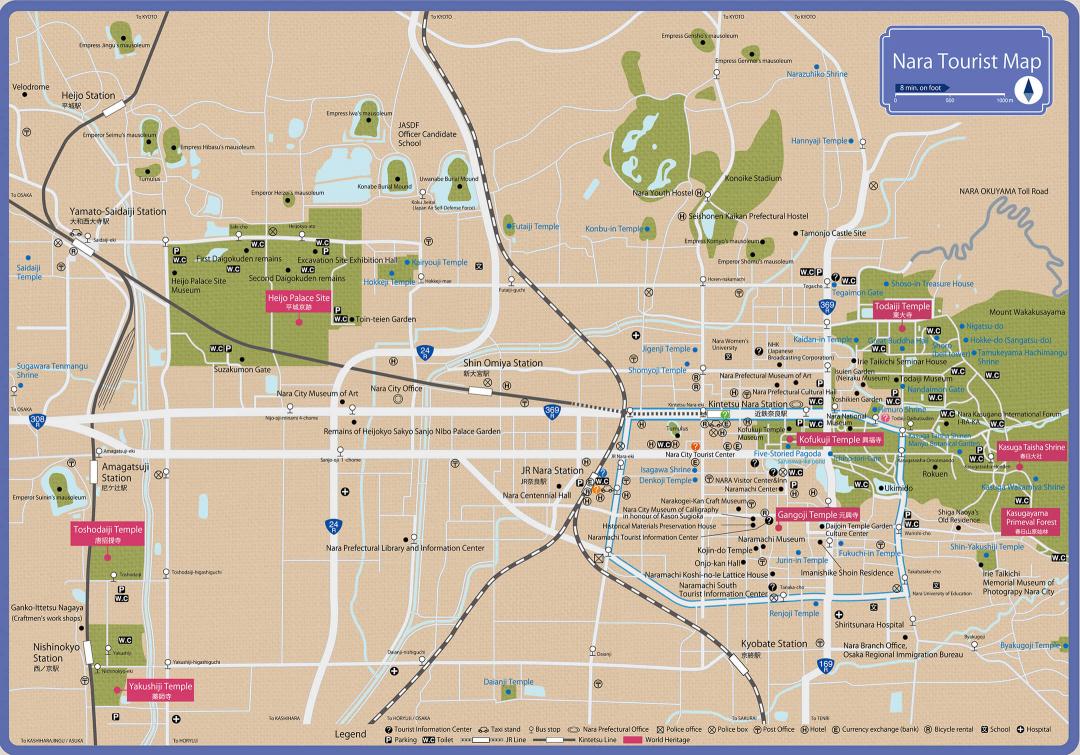NARA TRAVEL GUIDE
Welcome to Nara City!
Nara is a city with 1,300 years of cultural history, where deer and people live together in bountiful nature.
There are numerous tourist attractions such as the eastern district, with the original scenery of Japan still remaining, and "Naramachi" with its old townscape, as well as World Cultural Heritages such as Todaiji Temple.

NARA TRAVEL GUIDE is a sightseeing guide provided by Nara City.
It is a tool designed for those visiting Nara, providing information about Nara City in their native languages, making it even easier to understand.

Installed at about 500 spots around the city,The above QRT Code is displayed in hotels, ryokan (Japanese style accomodations), on signboards and at main facilities .
If you see a QRT Code, please scan the QR code.
Useful sightseeing information is provided.
Experience Nara City
World Heritage "Historic Monuments of Ancient Nara"
| Todaiji Temple |
At the wish of Emperor Shomu to protect the whole country through the teachings of Buddhism, a ceremony to consecrate the Great Buddha by inserting the eyes of the statue was held in 752. Daibutsuden (the Great Buddha Hall), one of the largest wooden structures in the world, enshrines the famous buddha Vairocana, commonly known as “Nara no Daibutsu-sama.” |
| Kohfukuji Temple |
Kohfukuji had great power as the temple of the Fujiwara clan between the 7th and the 17th centuries. It lost many buildings during several fires and from anti-Buddhist movements. However, currently the Central Golden Hall or chūkon-dō, is being reconstructed. Various precious National Treasures and Important Cultural Properties headed by the statue of an Asura are preserved. |
| Kasuga Taisha Shrine | Built from the wish for the prosperity of the country and the happiness of the people approximately 1,300 years ago. The roughly 3,000 garden lanterns within the precincts continue to be time-honored offerings to the temples. The great number of the lanterns tells of the deep faith the people hold. Kasuga Taisha Shrine >tap for details |
| Kasugayama Primeval Forest | Along with Mt. Mikasayama, the primeval forest was regarded to be divine and has been protected as a holy area from the perspective about nature the Japanese have, and their belief in Kasuga. The scenery is carved from the culture. Kasugayama Primeval Forest >tap for details |
| Gangoji Temple |
Previously being the Hokoji Temple (Asukadera Temple) built in Asuka at the end of the 6th century, even today, the oldest roof tiles are used on some parts of the Gokurakudo Hall and Zenshitsu Room. The Naramachi townscape has been preserved primarily by Gangoji Temple. |
| Yakushiji Temple | It was built in Fujiwara-kyō after the Emperor Tenmu requested its construction. The temple was moved to its current location when the capital was moved to Heijō-kyō in 710. There are many temple treasures and Cultural Properties that were passed on, such as Buddhist statues of the Nara period like the statues of the Yakushi Triad and a statue of Holy Kanzeon bosatsu (Avalokitesvara bodhisattva). Also, the eastern and western pagodas are known as beautiful three-story pagodas having a unique pent-roof style on each story. The eastern pagoda is undergoing dismantlement and repair, which is scheduled to be completed in 2019. Yakushiji Temple >tap for details |
| Toshodaiji Temple | Built by the Buddhist priest Ganjin (Jianzhen) following his arrival in Japan after many hardships. Important Buddhist temples and many masterpieces remain, including the Kondo Hall which became famous for appearing in the novel Tempyo-no-iraka (The Roof Tile of Tempyo) by Inoue Yasushi. Toshodaiji Temple >tap for details |
| Nara Palace site |
Heijō-kyō was the capital of Japan, having moved from Asuka Fujiwara-kyō in 710. The imperial domicile and government offices concentrated in Heijō Palace lie in the center. In addition to the restored Former Imperial Audience Hall (Dai-ichiji Daigokuden) and the Suzaku Gate, the resource centers enable you to imagine the old times. |
Natural Monument: The Deer of Nara
The Deer of Nara >tap for details
Traditional Crafts and Industries of Nara
Traditional Crafts and Industries of Nara >tap for details
Nara Specialty goods
Nara Specialty goods >tap for details
Some tips for staying in Nara
How to use Japanese toilets
How to use Japanese toilets >tap for details
How to take a Japanese-style bath
How to take a Japanese-style bath >tap for details
How to use the coin-operated lockers
How to use the coin-operated lockers (Todaiji Museum) >tap for details
Precautions for when staying in Nara
Restrictions on photography
Restrictions on photography >tap for details
Website providing information in the event of a disaster
External website(http://www.jnto.go.jp/safety-tips/mobile/) >tap for details
>>Nara City Sightseeing Guide top

